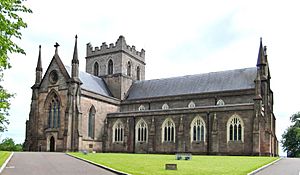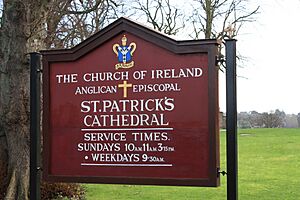St Patrick's Cathedral, Armagh (Church of Ireland) facts for kids
Quick facts for kids The Cathedral Church of St Patrick, Armagh |
|
|---|---|
| Cathedral of the Diocese of Armagh and Metropolitan Cathedral of the United Provinces of Armagh and Tuam | |
 |
|
| 54°20′52″N 6°39′22″W / 54.3478°N 6.6562°W | |
| Country | Northern Ireland |
| Language(s) | English |
| Denomination | Church of Ireland |
| Previous denomination | Roman Catholic |
| History | |
| Founded | AD 445 |
| Founder(s) | Saint Patrick |
| Dedication | Saint Patrick |
| Consecrated | AD 445 |
| Administration | |
| Diocese | Armagh |
| Province | Armagh |
St Patrick's Cathedral is an important church in Armagh, Northern Ireland. It belongs to the Church of Ireland. This cathedral is the main church for the Anglican Archbishop of Armagh.
The church stands on a very old site. It is believed that St. Patrick himself started a monastery here in the 5th century. For many years, it was the main Catholic church in Gaelic Ireland. It was also the seat of the Catholic Archbishop of Armagh.
In the 16th century, during the Protestant Reformation, the cathedral became part of the Protestant Church of Ireland. Today, Armagh City has two cathedrals named St Patrick's. The other one is the Catholic St Patrick's Cathedral, built later.
Contents
History of the Cathedral
Early Beginnings
This cathedral has always been a very important religious place in Ireland. People believe that Saint Patrick founded a church on this spot in 445 AD. Before that, the hilltop might have been a special place for ancient pagan worship.
By the 7th century, the site grew into a major monastery and a famous school. A whole monastic settlement developed around it.
Important Visitors and Events
Brian Boru, a powerful High King of Ireland, visited Armagh in 1004. He recognized the cathedral as the most important church in Ireland. He even gave it a large amount of gold. After he died in the Battle of Clontarf in 1014, Brian Boru was buried at Armagh Cathedral.
The cathedral was damaged and rebuilt many times over the centuries. For example, a big fire in 1511 caused a lot of damage. It was repaired by Dean Eoghan McCawell. However, by 1603, after the Nine Years' War, Armagh and its cathedral were in ruins.
During the Protestant Reformation, the cathedral became part of the Church of Ireland. It has been an Anglican church ever since the time of Queen Elizabeth I.
Modern Times
After the Nine Years' War, English control grew in Armagh. Many Protestant settlers from Britain moved to the area. This was part of the Plantation of Ulster.
During the Irish Rebellion of 1641, many Protestant settlers sought safety inside Armagh Cathedral. Catholic rebels later took control of the town until May 1642.
The cathedral was greatly rebuilt between 1834 and 1840. Archbishop Lord John George Beresford led this project. The architect was Lewis Nockalls Cottingham. They kept much of the original medieval structure. However, they also added many new parts.
Inside the cathedral, you can see many old Celtic and medieval carvings. There are also beautiful sculptures from the 18th and 19th centuries. These include works by famous artists like Francis Leggatt Chantrey and Louis-François Roubiliac.
The cathedral has a long tradition of choral music. This tradition dates back to the Culdees, an ancient group of monks. Today, there are singers called Lay Vicars Choral and boy choristers.
In 2008, a special event called the Maundy Money distribution took place at the cathedral. A plaque inside remembers this occasion.
Notable People Buried Here
Many important people are buried at St Patrick's Cathedral.
- Brian Boru (around 942–1014), a famous High King of Ireland.
- Saint Ethnea, who was baptized by St Patrick. She died around 433 AD.
- Lord John Beresford (1773–1862), who was an Archbishop of Armagh.
- Marcus Gervais Beresford (1801–1885), another Archbishop of Armagh. He was a cousin of Lord John Beresford.
- Charles Frederick D'Arcy (1859–1938), also an Archbishop of Armagh.
Organists of the Cathedral
The cathedral has had many talented organists over the years. Here are some of them:
- 1634 Richard Galway
- 1661 John Hawkshaw
- 1695 Robert Hodge
- 1711 William Toole
- 1722 Samuel Bettridge
- 1752 John Woffington
- 1759 Robert Barnes
- 1776 Langrishe Doyle
- 1782 Richard Langdon
- 1794 John Clarke Whitfield
- 1797 John Jones
- 1816 Frederick Horncastle
- 1823 Robert Turle
- 1872 Thomas Marks
- 1917 G. H. P. Hewson
- 1920 Edred Chaundy
- 1935 Reginald West
- 1951 Frederick Carter
- 1966 Christopher Phelps
- 1968 Martin White
- 2002–2015 Theo Saunders
- 2015–present Stephen Timpany
See also
- Dean of Armagh, a list of the deans of the cathedral
- List of cathedrals in Ireland
- St Patrick's Cathedral, Armagh (Roman Catholic)



